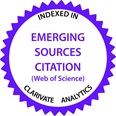Tytuł
Współpraca w chmurze w pandemii z perspektywy wykorzystania platform komunikacyjnych
Keywords
user experience, Unified Communication and Collaboration (UCC), collaboration platforms
Słowa kluczowe
doświadczenie użytkownika UX,komunikacja zintegrowana UCC,platformy komunikacyjne
Abstract
Purpose: The aim of this research is focused on the identification of communication patterns prior and after COVID-19 was announced and the approach to the choices that end users make in various aspects of life. Design/methodology/approach: The authors decided to execute two-step research including practical use of 4 popular collaboration platforms: Microsoft Teams, Zoom, Jitsi, Google Meet, based on the proved user experience. After a defined focus group of respondents gathered hands-on experience in a controlled manner, using the defined communication platforms, further research was carried out in the form of a survey to assess the change of behavior of respondents, considering IT tools used to support distance learning and collaboration. The research included a comparison of behavior prior the epidemic and during the epidemic period. The research covered the following aspects: how the behavior patterns of UCC use have changed across the identified areas (business, educational, private) and what are the most preferred toolsets. The following structure was applied: a short introduction to the communication platforms, definition of the research method, analysis, and discussion of the identified results. Findings: The conducted survey identified the following elements: the level of digital communication among respondents and the familiarity with different platforms have a significant role in the use and development of UCC platforms. The generic conclusion of the research was that almost all respondents have prior experience using UCC platforms. The survey has proved the 100% use of UCC cross various areas of life. Based on the research, it has been noticed that respondents tend to use one or two UCC platforms as a standard for business and private use. UCC platforms that are more widely used across different areas of life are rated as the most preferred by the respondents and include Microsoft Teams (30%) and Google Meet (23%). Research limitations/implications: The usage of non-probabilistic sampling, a relatively small sample and the usage of qualitative analysis methods were major limitations of the conducted research. Firstly, the research data was collected from students of one specialty, from one specific university. The research did not find any cultural differences in distance learning and communication. Secondly, the study uses basic statistical measures without cross analysis to enable a deeper analysis of the research. Originality/value: The presented paper is a part of the research area related to communication platforms across various areas of peoples’ life. The research was aimed at the identification of the most preferable UCC platforms and features that serve the communication purpose. The cognitive value of the paper might also be seen in the focus on a relatively narrow and homogenous group of respondents (students of e-business and digital marketing).
Abstrakt
Cel: identyfikacja wzorców komunikacji przed i po ogłoszeniu COVID-19 oraz podejścia użytkowników końcowych do wyboru platform komunikacyjnych wykorzystywanych w różnych aspektach życia. Projekt/metodologia/podejście: autorzy postanowili przeprowadzić dwuetapowe badanie, obejmujące praktyczne wykorzystanie 4 popularnych platform komunikacyjnych: Microsoft Teams, Zoom, Jitsi, Google Meet, oparte na zweryfikowanym doświadczeniu użytkowników. Po wspólnym wykorzystaniu przez grupę studentów na zajęciach zdefiniowanych platform komunikacyjnych przeprowadzono dalsze badania w formie ankiety, mającej na celu ocenę zmiany zachowań respondentów, z uwzględnieniem narzędzi informatycznych wykorzystywanych do nauki na odległość, komunikacji i współpracy. Badania obejmowały porównanie zachowań przed ogłoszeniem epidemii oraz w początkowym okresie epidemii oraz następujące aspekty: zmiana wzorców zachowań, związana z korzystaniem UCC w zidentyfikowanych obszarach (biznesowym, edukacyjnym, prywatnym) oraz identyfikację najbardziej preferowanych platform komunikacyjnych lub narzędzi wspierających komunikację. Zastosowano następującą strukturę: krótkie wprowadzenie do koncepcji platform komunikacyjnych, określenie metody badawczej, analiza i omówienie zidentyfikowanych wyników. Wnioski: w przeprowadzonym badaniu zidentyfikowano następujące elementy: poziom komunikacji cyfrowej wśród respondentów oraz znajomość różnych platform odgrywają istotną rolę w wykorzystaniu i preferencjach platform UCC. Ogólny wniosek z badania był taki, że prawie wszyscy respondenci mają wcześniejsze doświadczenie w korzystaniu z platform UCC. Badanie wykazało, że podejście wskazuje 100% wykorzystanie UCC w różnych dziedzinach życia. Na podstawie przeprowadzonych badań zauważono, że respondenci zwykle używają standardowo jedną lub dwie platformy UCC w przypadku wykorzystania biznesowego i prywatnego. Platformy UCC, które są częściej wykorzystywane w różnych dziedzinach życia są oceniane jako najbardziej preferowane przez respondentów i są nimi Microsoft Teams (30%) i Google Meet (23%). Ograniczenia/implikacje badawcze: głównymi ograniczeniami prowadzonych badań było wykorzystanie próby nieprobabilistycznej, stosunkowo małej próby oraz wykorzystanie metod analizy jakościowej. Po pierwsze, dane badawcze zostały zebrane od studentów jednej specjalności i z jednej konkretnej uczelni. Badania nie wykazały różnic kulturowych w nauczaniu na odległość i komunikacji. Po drugie, badanie wykorzystuje podstawowe miary statystyczne bez analizy krzyżowej, w celu przeprowadzenia głębszej analizy. Oryginalność/wartość: prezentowany artykuł wpisuje się w obszar badawczy związany z platformami komunikacyjnymi w różnych obszarach życia. Badanie miało na celu identyfikację preferowanych platform UCC oraz funkcjonalności najwyżej ocenianych jako przydatne do celów komunikacyjnych. Wartość poznawczą artykułu można dostrzec także w odniesieniu do stosunkowo jednorodnej grupy respondentów (studentów kierunków e-biznesu i marketingu cyfrowego).
Recommended Citation
Kubacz-Szumska, J., & Szumski, O. (2021). Cloud Communications During the Pandemic From the Perspective of Collaboration Platforms. Problemy Zarządzania, 19(93), 138-149. https://doi.org/10.7172/1644-9584.93.7
First Page
138
Last Page
149
Page Count
11
DOI
10.7172/1644-9584.93.7
Publisher
University of Warsaw








